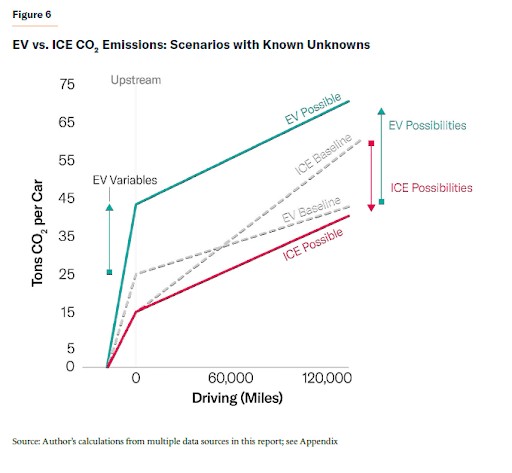Click Here for 150+ Global Oil Prices 
Click Here for 150+ Global Oil Prices 
Click Here for 150+ Global Oil Prices 
Click Here for 150+ Global Oil Prices 
Click Here for 150+ Global Oil Prices 
Click Here for 150+ Global Oil Prices 
Click Here for 150+ Global Oil Prices 
Click Here for 150+ Global Oil Prices 
UK Sets £1.08 Billion Offshore Wind Budget In 2030 Push
Find us on:
President Trump said he will…
America’s rapid expansion of liquefied…
Recycling outdated renewable energy components,…
Alex Kimani
Alex Kimani is a veteran finance writer, investor, engineer and researcher for Safehaven.com.
More Info
Electric vehicle skeptics often squawk that battery-electric vehicles like Teslas are nowhere nearly as friendly to the environment as their proponents claim. Well, the truth is a bit more nuanced. Whereas the initial manufacturing of EVs, particularly their batteries, does have a significantly higher carbon footprint than internal combustion engine (ICE) cars, many life cycle assessments consistently show that EVs have significantly lower total greenhouse gas emissions than gasoline or diesel vehicles once they are on the road. Unfortunately, this does not apply equally for all BEVs: a new study by Transport and Environment (T&E) has revealed that plug-in hybrid electric vehicles (PHEV) have a carbon and emissions footprint in real life conditions comparable to gas cars, much higher than previously thought.
A T&E analysis of 127,000 PHEVs registered in the EU in 2023 found that they emit 135g of CO2 per km on average, more than 80% of the 166g of CO2/km produced by petrol and diesel vehicles on average. This means PHEVs produce nearly 5x higher C02 emissions in the real world compared to levels recorded under lab-conditions, and that they lower emissions by only 19% compared to ICEs and not the 75% figure often cited by manufacturers.
Not to be confused with traditional hybrid electric vehicles (HEVs), the main difference between PHEVs and HEVs is that PHEVs have a larger battery that can be charged externally, while HEVs use a smaller battery that is recharged internally through regenerative braking and the gasoline engine. This allows PHEVs to drive significantly longer distances on electricity alone, whereas HEVs primarily rely on the gasoline engine with the electric motor acting as a support for better fuel efficiency. Unfortunately, the larger and heavier batteries in PHEVs result in higher fuel consumption and increased emissions. PHEVs fire up gas engines to provide extra power under demanding driving conditions such as higher speeds or steep inclines, leading to a consumption of ~3 liters of fuel per 100 kilometers even while operating in electric mode. This results in PHEVs emission 68g of CO2 per kilometer when operating on an electric-only-mode, or about 8.5x the official prediction.
Related: UK Sets £1.08 Billion Offshore Wind Budget In 2030 Push
Lifetime Emissions
Two years ago, the Manhattan Institute compiled a comprehensive report comparing lifetime greenhouse gas emissions of EVs and ICEs by looking at dozens of data points and parameters.
According to the report, EVs in general have a much wider range of potential greenhouse gas emissions (GHG) than ICEs, mainly due to much wider variations in upstream (mining+ manufacturing) emissions by electric cars. Indeed, the study found that the differences are such that the dirtiest EVs can have higher lifetime emissions than the cleanest gas cars.
That said, lifetime emissions by EVs are generally lower than by ICEs. In base-case scenarios in the Manhattan Institute study, EVs have higher initial emissions due to the energy intensity of the battery metals used in the manufacturing process; however, they eventually catch up to ICEs around the 60,000 driven miles mark.
Vehicle emissions are generally divided into two general categories: air pollutants, which contribute to health problems, and greenhouse gases (GHGs), such as carbon dioxide and methane. Both categories of emissions are frequently evaluated on a tailpipe basis, a well-to-wheel basis, and a cradle-to-grave basis. Well-to-wheel emissions are emissions related to fuel production, processing, distribution, and use while cradle-to-grave emissions include well-to-wheel emissions as well as vehicle-cycle emissions associated with vehicle and battery manufacturing, recycling, and disposal.
The good news: whereas these studies have arrived at varying emission figures, they have invariably found that the greenhouse-gas emission difference caused by the carbon-intensive production of BEVs vs. ICE vehicles is virtually erased in the first few years of an EV’s life. In one such study conducted by the University of Michigan, it takes 1.4 to 1.5 years for EV sedans to erase the pollution advantage of ICE vehicles due to the manufacturing process; 1.6 to 1.9 years for SUVs, and about 1.6 years for pickup trucks. These numbers are based on the average number of vehicle miles driven in the United States.
According to the study, on average, emissions from B.E.V. sedans are ~35% of the emissions from an internal-combustion sedan; electric S.U.V.s produce ~37% of the emissions of a gasoline-powered vehicle, while B.E.V. pickups create ~34% of the emissions of an internal combustion model. All-electric vehicles, plug-in hybrid electric vehicles (PHEVs), and hybrid electric vehicles (HEVs, which operate as EVs for limited distances), produce lower tailpipe emissions than ICE vehicles, and zero tailpipe emissions when they run only on electricity.
By Alex Kimani for Oilprice.com
More Top Reads From Oilprice.com
Back to homepage
Alex Kimani is a veteran finance writer, investor, engineer and researcher for Safehaven.com.
How One Pipeline Turned Canada Into a Global Energy Power
U.S. Funds Tighten Grip on Canada’s Oil Patch
U.S. Rare Earth Company Signs Strategic Deal With Japanese Government
New Sodium-Ion Battery Breakthrough Doubles Charge and Desalinates Water
StanChart Finally Turns Bearish, Cuts Oil Price Forecast By $15/bbl
ADVERTISEMENT
© OilPrice.com
The materials provided on this Web site are for informational and educational purposes only and are not intended to provide tax, legal, or investment advice.
Nothing contained on the Web site shall be considered a recommendation, solicitation, or offer to buy or sell a security to any person in any jurisdiction.
Merchant of Record: A Media Solutions trading as Oilprice.com











